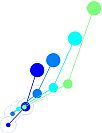The two first authors contributed equally to this work.
Humans navigate their semantic memory to find new ideas when trying to be creative. Understanding how this happens is essential for unpacking the cognitive mechanisms of goal-directed processes such as creativity. Creativity can be defined as the ability to produce ideas that are both original and adequate to the context, and is traditionally thought to involve both a spontaneous generative process and a goal-directed evaluative process.
Our study aims to challenge this view, proposing that the generative process also relies on goal-directed mechanisms. Particularly, we hypothesise that search trajectories during creative idea generation are driven by the relevant dimensions for creativity, i.e., originality and adequacy.
To test this, we adapted a creativity task, the Free Generation of Associates Task (FGAT), requiring participants to produce associations in response to cue words, following three instructions (conditions): 1) spontaneous associations (non-creative, non-goal directed), 2) creative associations (creative, goal-directed), and 3) positive associations (non-creative, goal-directed). The main manipulation was to make it fluent, such that participants had to verbalise each word that reached their mind before providing a final response. Participants rated their responses for adequacy and originality to access the goal-relevant dimensions for creativity, as well as valence and likeability, across two experiments (online, n=157; on-site, n=45).
We replicated previous results showing that goal-relevant dimensions (i.e., originality and adequacy) explained participants likeability ratings. Additionally, we found that the adequacy ratings decreased across response rank for each cue similarly in the spontaneous and creative conditions, whereas originality increased faster in the creative condition. We then tested how goal-relevant dimensions related to the probability of transitions between successive responses. Preliminary analyses revealed that transitions were partly driven by originality and adequacy during the creative condition but not during the spontaneous condition.
Altogether, these preliminary results pledge for a goal-directed process in creative idea generation. They allow the validation of an experimental and statistical design to later investigate trajectories in semantic memory during goal-directed search in clinical populations, such as patients with schizophrenia.

 PDF version
PDF version
